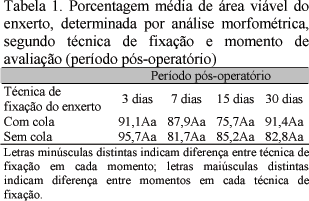The purpose of this study was to evaluate the efficiency of fibrin glue, derived from snake venom, on fixation and integration of skin graft. Nine crossbred dogs, with average weight of 15kg were used. Wounds measuring 4×4 cm were induced at the cranioproximal aspect of the right and left forelimb. Full-thickness skin grafts were harvested from thoracic area, and meshed with a commercial mesh dermatome. The graft was secured to the recipient bed using several simple interrupted sutures on the right forelimb. On the left forelimb fibrin glue and eight simple interrupted sutures were used. The bed was closed using bipedicle advancement flap. The non-adherent occlusive bandage and neomycin-bacitracin ointment were used on receptor bed. The bandage was changed every day until the seventh day postoperative and every three days afterwards. The graft survival area was obtained by subtraction of total and nonviable areas measured with a Nikon Photomicroscope connected to a KS-300 image analysis system at 3, 7, 15 and 30 days postsurgically. For microscopic evaluation, the skin graft, recipient bed and adjacent surrounding skin were collected at 7, 15 and 30 days postsurgery. No statistical difference was detected for the viable graft area, in each evaluation moment and between fixation methods. However, based on microscopic evaluation, fibrin glue enhanced the tissue repair process in all evaluation moments. It was possible to conclude that fibrin glue derived from snake venom has moderate adhesive capacity, and, based on microscopic examination, improves the integration of full-thickness mesh skin grafts.
fibrin glue; skin graft; suture; snake




